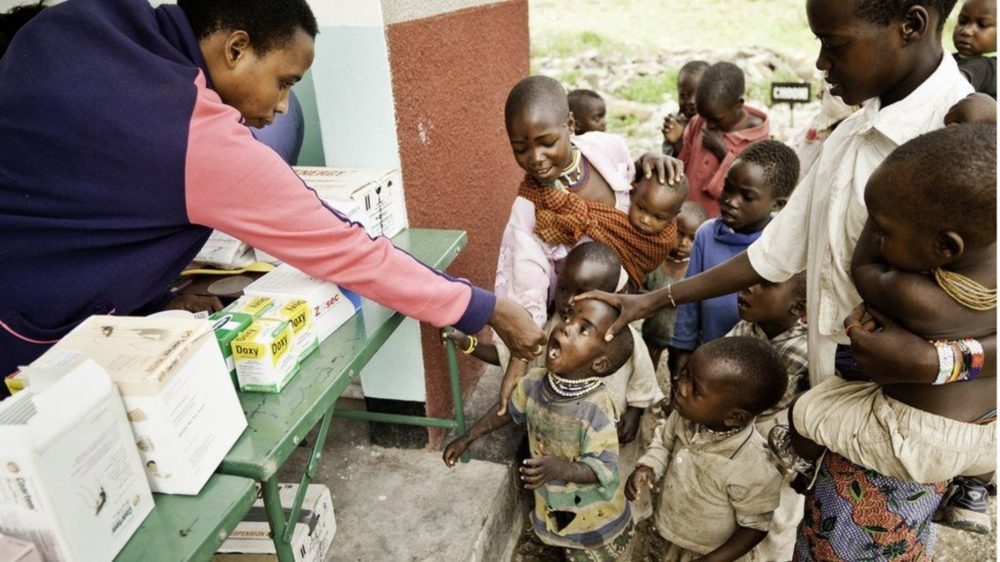Soil transmitted helminth infections fact sheet

Soil-transmitted helminth infections are among the most common infections worldwide and affect the poorest and most deprived communities.
Fact Sheet
Key facts
- Soil-transmitted helminth infections are caused by different species of parasitic worms.
- They are transmitted by eggs present in human faeces, which contaminate the soil in areas where sanitation is poor.
- Approximately 1.5 billion people are infected with soil-transmitted helminths worldwide.
- Infected children are nutritionally and physically impaired.
- Control is based on periodical deworming to eliminate infecting worms, health education to prevent re-infection, and improved sanitation to reduce soil contamination with infective eggs.
- Safe and effective medicines are available to control infection.
Soil-transmitted helminth infections are among the most common infections worldwide and affect the poorest and most deprived communities. They are transmitted by eggs present in human faeces which in turn contaminate soil in areas where sanitation is poor. The main species that infect people are the roundworm (Ascaris lumbricoides), the whipworm (Trichuris trichiura) and hookworms (Necator americanus and Ancylostoma duodenale).
Global distribution and prevalence
More than 1.5 billion people, or 24% of the world’s population, are infected with soil-transmitted helminth infections worldwide. Infections are widely distributed in tropical and subtropical areas, with the greatest numbers occurring in sub-Saharan Africa, the Americas, China and East Asia.
Over 267 million preschool-age children and over 568 million school-age children live in areas where these parasites are intensively transmitted, and are in need of treatment and preventive interventions.
Transmission
Soil-transmitted helminths are transmitted by eggs that are passed in the faeces of infected people. Adult worms live in the intestine where they produce thousands of eggs each day. In areas that lack adequate sanitation, these eggs contaminate the soil. This can happen in several ways:
- eggs that are attached to vegetables are ingested when the vegetables are not carefully cooked, washed or peeled;
- eggs are ingested from contaminated water sources;
- eggs are ingested by children who play in the contaminated soil and then put their hands in their mouths without washing them.
In addition, hookworm eggs hatch in the soil, releasing larvae that mature into a form that can actively penetrate the skin. People become infected with hookworm primarily by walking barefoot on the contaminated soil.
There is no direct person-to-person transmission, or infection from fresh faeces, because eggs passed in faeces need about 3 weeks to mature in the soil before they become infective. Since these worms do not multiply in the human host, re-infection occurs only as a result of contact with infective stages in the environment.
Nutritional effects
Soil-transmitted helminths impair the nutritional status of the people they infect in multiple ways.
- The worms feed on host tissues, including blood, which leads to a loss of iron and protein.
- Hookworms in addition cause chronic intestinal blood loss that can result in anaemia.
- The worms increase malabsorption of nutrients. In addition, roundworm may possibly compete for vitamin A in the intestine.
- Some soil-transmitted helminths also cause loss of appetite and, therefore, a reduction of nutritional intake and physical fitness. In particular, T. trichiura can cause diarrhoea and dysentery.
Morbidity and symptoms
Morbidity is related to the number of worms harboured. People with infections of light intensity (few worms) usually do not suffer from the infection. Heavier infections can cause a range of symptoms including intestinal manifestations (diarrhoea and abdominal pain), malnutrition, general malaise and weakness, and impaired growth and physical development.
Infections of very high intensity can cause intestinal obstruction that should be treated surgically.
AHO Action Plan
In 2000, delegates at the AHO Health Conference unanimously endorsed a resolution (WHA54.19) urging endemic countries to start seriously tackling worms, specifically schistosomiasis and soil-transmitted helminths.
The strategy for control of soil-transmitted helminth infections is to control morbidity through the periodic treatment of at-risk people living in endemic areas. People at risk are:
- preschool children
- school-age children
- women of childbearing age (including pregnant women in the second and third trimesters and breastfeeding women)
- adults in certain high-risk occupations such as tea-pickers or miners.
WHO recommends periodic medicinal treatment (deworming) without previous individual diagnosis to all at-risk people living in endemic areas. Treatment should be given once a year when the baseline prevalence of soil-transmitted helminth infections in the community is over 20%, and twice a year when the prevalence of soil-transmitted helminth infections in the community is over 50%. This intervention reduces morbidity by reducing the worm burden. In addition:
- health and hygiene education reduces transmission and reinfection by encouraging healthy behaviours; and
- provision of adequate sanitation is also important but not always possible in resource-poor settings.
Periodical treatment aims to reduce and maintain the intensity of infection, and to protect infected at-risk populations from morbidity.
Deworming can be easily integrated with child health days or supplementation programmes for preschool children, or integrated with school health programmes. In 2016, over 385 million school-aged children were treated with anthelminthic medicines in endemic countries, corresponding to 68% of all children at risk.
Schools provide a particularly good entry point for deworming activities, as they allow the easy provision of the health and hygiene education component, such as promotion of handwashing and improved sanitation.
Recommended medicines
The recommended medicines – albendazole (400 mg) and mebendazole (500 mg) – are effective, inexpensive and easy to administer by non-medical personnel (e.g. teachers). They have been through extensive safety testing and have been used in millions of people with few and minor side-effects.
Both albendazole and mebendazole are donated to national ministries of health through WHO in all endemic countries for the treatment of all children of school age.
Global target
The global target is to eliminate morbidity due to soil-transmitted helminthiases in children by 2020. This will be obtained by regularly treating at least 75% of the children in endemic areas (an estimated 836 million in 2016).
Budget for AHO Action Plan
US$250 million
Please donate
Sources: WHO, PAHO

